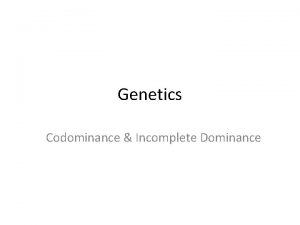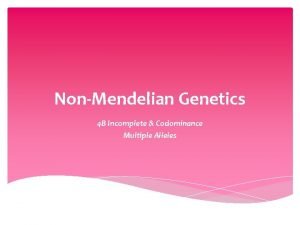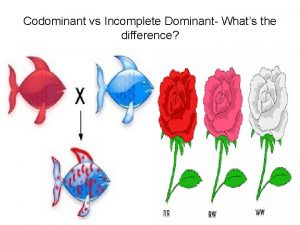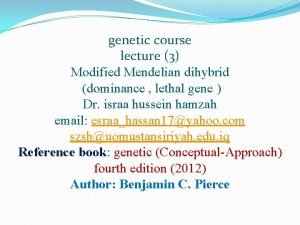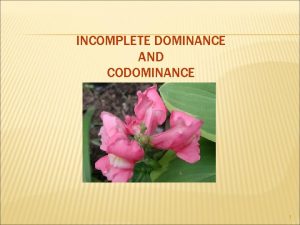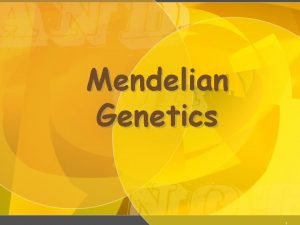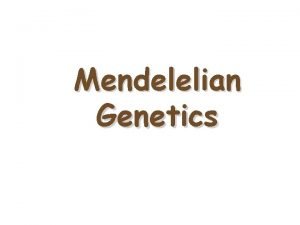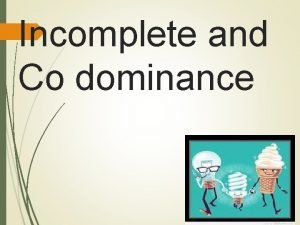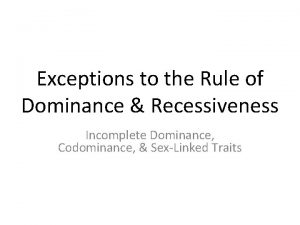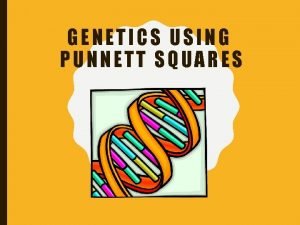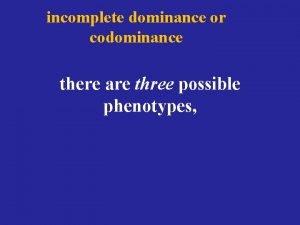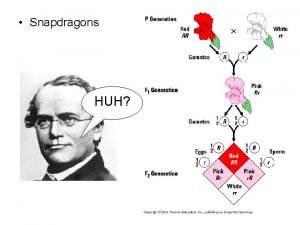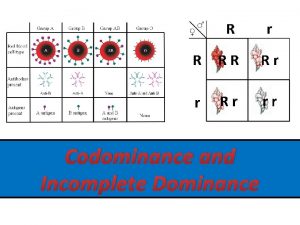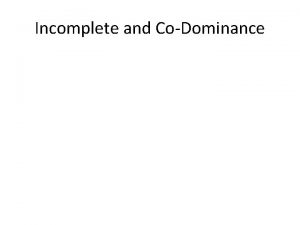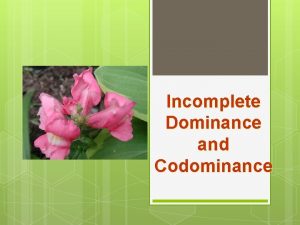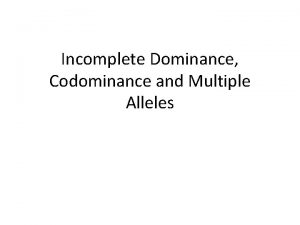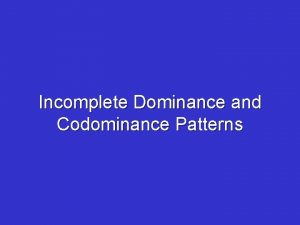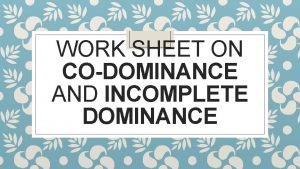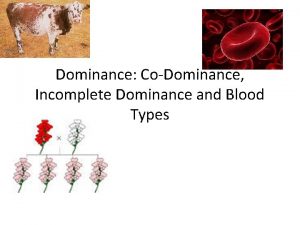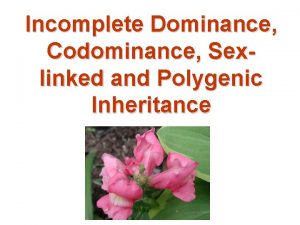Alterations to Mendel Incomplete or partial dominance Codominance


















- Slides: 18

Alterations to Mendel • • Incomplete or partial dominance Codominance Multiple alleles Lethal alleles Gene interactions & multiple genes Sex-linked, sex-limited, & sex-influenced Effect of environment Extranuclear inheritance 1

Multiple genes 2 • Sometimes a phenotype is controlled by more than one gene – Different from multiple alleles of same gene!! • Gene products don’t necessarily directly interact. – Genes may code for enzymes in a pathway – Cascade of gene during development • Epistasis: a gene (or gene pair) masks or modifies the expression of another gene (or gene pair).

3 Epistasis: gene interaction that perturbs normal Mendelian ratios • Example: interaction between two genes in the pathway for pigment production, C and P – C, P = dominant; c, p = recessive. – Because both genes are needed, if individual is homozygous recessive for either gene, no color. • Cc. Pp, all colored in F 1 • Cc. Pp x Cc. Pp 9: 7 phenotypic ratio – Do the Punnett square and see – Independent assortment still applies – Various interactions produce different ratios.

Epistasis example: Bombay phenotype 4 In the ABO blood groups, A and B are codominant. How can the person in this pedigree be type O (IO IO)?

Epistasis example: explanation A second gene, Ih codes for the base sugar chain to which the A and B sugars are added. A rare mutation Ih Ih prevents proper formation so that the A and B sugars cannot be added even though the enzyme for doing that is being made. (Diagram next slide) A second gene is masking the normal phenotype. 5

Molecular explanation 6

Complementation • Several different genes may contribute to phenotype. • How can you tell whether a phenotype results from one gene or from several? • Create several mutants with the same phenotype. • Perform complementation tests: Cross different mutants. If mutations are in different genes, offspring will have one good copy of each gene, restoring WT phenotype: the mutants complement. If offspring show the mutant phenotype, mutation is in same gene. 7

8 http: //www. hort. purdue. edu/rhodcv/hort 640 c/proline/pr 00003. htm

Complementation example • Example: bacteria unable to make the amino acid proline. pro. B mutants: known mutations in the pro. B gene. pro. A mutants: have mutations in the pro. A gene, etc. In which proline gene does “pro-53” have a mutation? To find out, Create merozygotes. These are bacteria that have two copies of the genes of interest (bacteria normally have only one of each). “Cross” pro-53 with each of the known mutants. 9

Complementation crosses 10 The unknown mutant (pro-53) is “crossed” with each of the other types of mutants. Does the cross result in a “cure” (the bacterium can now make proline) or is it still defective? In this cross, DNA from a pro. A- mutant is added to the pro-53 bacterium. The presence of this DNA is unable to rescue pro-53 (does not complement), because the mutation is in the SAME gene. The pro-53 must be a pro. A mutant.

The other crosses pro-53 said to be in same complementation group as other pro-A mutants. What happens when pro-53 is crossed with a pro. B mutant? The added DNA cures pro-53 because now it has good copies of all 3 genes: a+ b+ c+ Do a cross with a pro. C mutant. 11

The sex chromosomes 12 • The rest of the chromosomes are autosomes. – Sex chromosomes determine sex of individual. • X and Y differ in size, X much bigger in humans – But still synapse during meiosis, so still a pair • In humans, fruit flies, XX = female; XY = male. • In several other organisms, other combinations of sex chromosomes determine sex. • Because there are genes on sex chromosomes, inheritance of certain traits can be sex-linked.

Sex linked, limited, & influenced 13 • Sex linked inheritance is when the allele is present on a sex chromosome (usually X). • Sex limited: when other genetic factors restrict expression to one sex – Bulls don’t give milk. • Sex influenced: other genetic factors modulate expression. Example: pattern baldness – Females must be homozygous recessive for trait – Even then, hormonal factors restrict expression.

Environmental factors 14 • Expression of genes is affected by genetic background (internal environment) but also by the external environment. • Penetrance vs. Expressivity – Penetrance refers to percentage of individuals in a population that show the trait to some extent. • 6 fingers is a dominant trait, but… – Expressivity: the degree to which the trait is expressed within an individual.

External environment 15 • Numerous examples in other organisms, e. g. sex determination in turtles and crocodiles. • Temperature effects – Conditional mutations, especially temperature sensitive mutations. Permissive vs. restrictive. – Himalayan rabbit, Siamese cat – Lethal genes in microbes • Growth and development – Various human diseases, strike at various times of development. E. g. Huntington disease. www. tcainc. org/photos/ farpoint/saavik 1. jpg

Mitochondrial Inheritance 16 Endosymbiont hypothesis: mitochondria descended from endosymbiotic bacteria. Outer membrane separates organelle from cytoplasm. Inner membrane site of ATP synthesis. Inner and outer membranes analagous to Gram negative bacteria. Mitochondria have their own DNA, ribosomes, t. RNA (all bacteria-like) and replicate independently of cell cycle. www. protein-ms. de/ RES/Mito/mito. htm

Mitochondrial Inheritance-2 • Mitochondria well integrated into cell – Some genes for structure & function of the mitochondrion are found in the nucleus. – Not a completely independent entity. • Mutations in Mt DNA cause genetic diseases which reflect function of mitochondria – Major function: ATP generation – Diseases feature breakdown of function in tissues requiring high levels of ATP • Muscle and nerve tissue disorders 17

Mitochondrial inheritance is maternal • During meiosis in females, cell division is asymmetric with most of the cytoplasm including mitochondria going into the eventual ovum. • Spermatozoa are DNA delivery devices with little cytoplasm. http: //www. ucalgary. ca/Uof. C/eduweb/virtualembryo/Page. Mill_Images/image 145. gif yalenewhavenhealth. org/ library/healthguide/en. . . 18
 Incomplete dominance punnett square
Incomplete dominance punnett square Codominant allele
Codominant allele Flower incomplete dominance
Flower incomplete dominance Whats incomplete dominance
Whats incomplete dominance The difference between dominance and codominance
The difference between dominance and codominance What is incomplete dominance give an example
What is incomplete dominance give an example Genotype and phenotype ratio
Genotype and phenotype ratio Incomplete dominance sickle cell anemia
Incomplete dominance sickle cell anemia Law of dominance
Law of dominance Law of independent assortment vs law of segregation
Law of independent assortment vs law of segregation Incomplete dominance
Incomplete dominance An organism’s physical appearance, or visible traits *
An organism’s physical appearance, or visible traits * Codominance
Codominance Incomplete dominance
Incomplete dominance When neither allele is dominant
When neither allele is dominant Punnett square problems
Punnett square problems Incomplete dominance
Incomplete dominance Andalusian chicken incomplete dominance
Andalusian chicken incomplete dominance Incomplete dominance pigments answer key
Incomplete dominance pigments answer key
